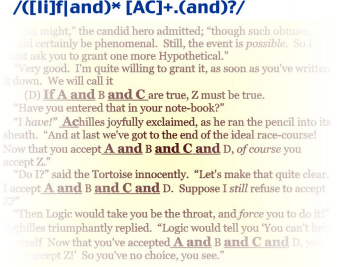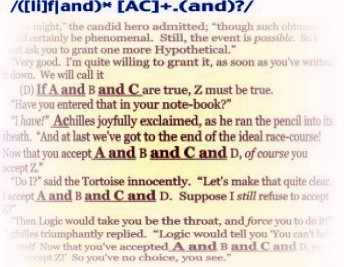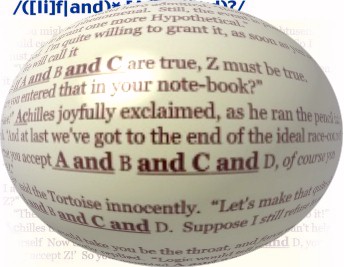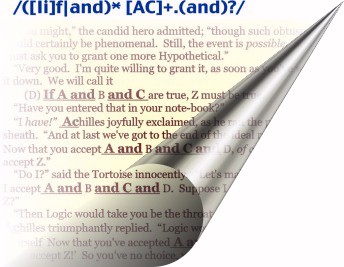
Unlike the IBM developerWorks version, this tutorial is just one big HTML file, with a few graphics used along the way. Just scroll down to read it. Printing may break some lessons in the middle--but then, you didn't pay much to get this.
This tutorial was published by IBM developerWorks. Their version is available in some additional formats like PDF, but with a (free of cost) registration requirements. This version contains a few minor corrections that readers have suggested since the original publication.
My web logs show that a surprisingly huge number of people read this page; so I might as well include some links to other areas my website, in case readers who link directly here do not know about them. If I were really clever, I would think of some way to separate readers from their money, but in my simplicity, everything here is free of cost and free of advertising (and I don't even sell anything else, except maybe my good name).
Publications of David Mertz * Technical Publications * Gnosis Software Home Page * My book: Text Processing in Python |
Unlike the IBM developerWorks version, this tutorial is just one big HTML file, with a few graphics used along the way. Just scroll down to read it. Printing may break some lessons in the middle--but then, you didn't pay much to get this. |
 |
This tutorial is aimed at users and programmers who have begun to work with tools that use regular expressions, but who are not quite comfortable with the intricacies of them. Even users who may have used regular expressions in the past, but have forgotten some of the details can benefit from this as a refresher. After completing this tutorial you will not yet be an expert in using regular expressions to best advantage. But this tutorial combined with lots of practice with varying cases is about all you need to be an expert. The concepts of regular expressions are extremely simple and powerful. . . it is their application that takes some work. |
 |
Read the tutorial to get the long answer. The short answer is that a regular expression is a compact way of describing complex patterns in texts. You can use them to search for patterns and, once found, to modify the patterns in complex ways. They can also be used to launch programmatic actions that depend on patterns. A tongue-in-cheek comment by programmers is worth thinking about: "Sometimes you have a programming problem and it seems like the best solution is to use regular expressions; now you have two problems." Regular expressions are amazingly powerful and deeply expressive. That is the very reason writing them is just as error-prone as writing any other complex programming code. It is always better to solve a genuinely simple problem in a simple way; when you go beyond simple, think about regular expressions. |
 |
A large number of tools incorporate regular expressions as part of
their functionality. Unix-oriented command line tools like
There are a few variations in regular expression syntax between
different tools that use them. Some tools add enhanced capabilities that
are not available everywhere. In general, for the simplest cases, this
tutorial will use examples based around |
 |
For purposes of presenting examples in this tutorial, regular
expressions described will be surrounded by forward slashes. This style of
delimiting regular expressions is used by
Read ahead to understand this example, for now just understand that the actual regular expression is everything between the slashes. Many examples will be accompanied by an illustration that shows a regular expression, and a text that is highlighted for every match on that expression. |
 |
David Mertz is a writer, a programmer, and a teacher, who always endeavors to improve his communication to readers (and tutorial takers). He welcomes any comments, please direct them to <mertz@gnosis.cx>. |
|
After you complete this tutorial you will have seen the basics (and a bit of some advanced topics) of regular expressions. The best thing to do next is to start using them in real-life problems. The first thing to look at is the documentation that accompanies the particular tool you use. Beyond that, a number of printed books have good explanations of regular expressions, often as implemented by specific tools. Some books the creator of this tutorial has benefited from are:
|
|
The very simplest pattern matched by a regular expression is a literal character or a sequence of literal characters. Anything in the target text that consists of exactly those characters in exactly the order listed will match. A lower case character is not identical with its upper case version, and vice versa. A space in a regular expression, by the way, matches a literal space in the target (this is unlike most programming languages or command-line tools, where spaces separate keywords). |
|
A number of characters have special meanings to regular expressions. A symbol with a special meaning can be matched, but to do so you must prefix it with the backslash character (this includes the backslash character itself: to match one backslash in the target, your regular expression should include "\\"). |
|
Two special characters are used in almost all regular expression tools to mark the beginning and end of a line: caret (^) and dollarsign ($). To match a caret or dollarsign as a literal character, you must escape it (i.e. precede it by a backslash "\"). An interesting thing about the caret and dollarsign is that they match zero-width patterns. That is the length of the string matched by a caret or dollarsign by itself is zero (but the rest of the regular expression can still depend on the zero-width match). Many regular expression tools provide another zero-width pattern for word-boundary (\b). Words might be divided by whitespace like spaces, tabs, newlines, or other characters like nulls; the word-boundary pattern matches the actual point where a word starts or ends, not the particular whitespace characters. |
|
In regular expressions, a period can stand for any character. Normally, the newline character is not included, but most tools have optional switches to force inclusion of the newline character also. Using a period in a pattern is a way of requiring that "something" occurs here, without having to decide what. Users who are familiar with DOS command-line wildcards will know the question-mark as filling the role of "some character" in command masks. But in regular expressions, the question-mark has a different meaning, and the period is used as a wildcard. |
|
A regular expression can have literal characters in it, and also zero-width positional patterns. Each literal character or positional pattern is an atom in a regular expression. You may also group several atoms together into a small regular expression that is part of a larger regular expression. One might be inclined to call such a grouping a "molecule," but normally it is also called an atom. In older Unix-oriented tools like |
|
Rather than name only a single character, you can include a pattern in a regular expression that matches any of a set of characters. A set of characters can be given as a simple list inside square
brackets, e.g. Many regular expression tools also provide escape-style shortcuts to
the most commonly used character class, such as |
|
The caret symbol can actually have two different meanings in regular expressions. Most of the time, it means to match the zero-length pattern for line beginnings. But if it is used at the beginning of a character class, it reverses the meaning of the character class. Everything not included in the listed character set is matched. |
|
Using character classes is a way of indicating that either on thing or another thing can occur in a particular spot. But what if you want to specify that either of two whole subexpressions occur in a position in the regular expression? For that, you use the alternation operator, the vertical bar ("|"). This is the symbol that is also used to indicate a pipe in Unix/DOS shells, and is sometimes called the pipe character. The pipe character in a regular expression indicates an alternation between everything in the group enclosing it. What this means is that even if there are several groups to the left and right of a pipe character, the alternation greedily asks for everything on both sides. To select the scope of the alternation, you must define a group that encompasses the patterns that may match. The example illustrates this. |
|
One of the most powerful and common things you can do with regular expressions is to specify how many times an atom occurs in a complete regular expression. Sometimes you want to specify something about the occurrence of a single character, but very often you are interested in specifying the occurrence of a character class or a grouped subexpression. There is only one quantifier included with "basic" regular expression syntax, the asterisk ("*"); in English this has the meaning "some or none" or "zero or more." If you want to specify that any number of an atom may occur as part of a pattern, follow the atom by an asterisk. Without quantifiers, grouping expressions doesn't really serve as much purpose, but once we can add a quantifier to a subexpression we can say something about the occurrence of the subexpression as a whole. Take a look at the example. |
|
In a certain way, the lack of any quantifier symbol after an atom quantifies the atom anyway: it says the atom occurs exactly once. Extended regular expressions (which most tools support) add a few other useful numbers to "once exactly" and "zero or more times." The plus-sign ("+") means "one or more times" and the question-mark ("?") means "zero or one times." These quantifiers are by far the most common enumerations you wind up naming. If you think about it, you can see that the extended regular
expressions do not actually let you "say" anything the basic ones do not.
They just let you say it in a shorter and more readable way. For example,
" |
|
Using extended regular expressions, you can specify arbitrary pattern occurrence counts using a more verbose syntax than the question-mark, plus-sign, and asterisk quantifiers. The curly-braces ("{" and "}") can surround a precise count of how many occurrences you are looking for. The most general form of the curly-brace quantification uses two range arguments (the first must be no larger than the second, and both must be non-negative integers). The occurrence count is specified this way to fall between the minimum and maximum indicated (inclusive). As shorthand, either argument may be left empty: if so the minimum/maximum is specified as zero/infinity, respectively. If only one argument is used (with no comma in there), exactly that number of occurrences are matched. |
|
One powerful option in creating search patterns is specifying that a
subexpression that was matched earlier in a regular expression is matched
again later in the expression. We do this using backreferences.
Backreferences are named by the numbers 1 through 9, preceded by the
backslash/escape character when used in this manner. These backreferences
refer to each successive group in the match pattern, as in
It is important to note something the example illustrates. What gets matched by a backreference is the same literal string matched the first time, even if the pattern that matched the string could have matched other strings. Simply repeating the same grouped subexpression later in the regular expression does not match the same targets as using a backreference (but you have to decide what it is you actually want to match in either case). Backreferences refer back to whatever occurred in the previous grouped expressions, in the order those grouped expressions occurred. Because of the naming convention (\1-\9), many tools limit you to nine backreferences. Some tools allow actual naming of backreferences and/or saving them to program variables. The more advanced parts of this tutorial touch on these topics |
|
Quantifiers in regular expressions are greedy. That is, they match as much as they possibly can. Probably the easiest mistake to make in composing regular expressions is to match too much. When you use a quantifier, you want it to match everything (of the right sort) up to the point where you want to finish your match. But when using the "*", "+" or numeric quantifiers, it is easy to forget that the last bit you are looking for might occur later in a line than the one you are interested in. |
|
Often if you find that your regular expressions are matching too much, a useful procedure is to reformulate the problem in your mind. Rather than thinking about "what am I trying to match later in the expression?" ask yourself "what do I need to avoid matching in the next part?" Often this leads to more parsimonious pattern matches. Often the way to avoid a pattern is to use the complement operator and a character class. Look at the example, and think about how it works. The trick here is that there are two different ways of formulating almost the same sequence. You can either think you want to keep matching until you get to XYZ, or you can think you want to keep matching unless you get to XYZ. These are subtly different. For people who have thought about basic probability, the same pattern occurs. The chance of rolling a 6 on a die in one roll is 1/6. What is the chance of rolling a 6 in six rolls? A naive calculation puts the odds at 1/6+1/6+1/6+1/6+1/6+1/6, or 100%. This is wrong, of course (after all, the chance after twelve rolls isn't 200%). The correct calculation is "how do I avoid rolling a 6 for six rolls?" -- i.e. 5/6*5/6*5/6*5/6*5/6*5/6, or about 33%. The chance of getting a 6 is the same chance as not avoiding it (or about 66%). In fact, if you imagine transcribing a series of dice rolls, you could apply a regular expression to the written record, and similar thinking applies. |
|
Not all tools that use regular expressions allow you to modify target
strings. Some simply locate the matched pattern; the mostly widely used
regular expression tool is probably Of the tools that allow you to modify target text, there are a few differences to keep in mind. The way you actually specify replacements will vary between tools: a text editor might have a dialog box; command-line tools will use delimiters between match and replacement, programming languages will typically call functions with arguments for match and replacement patterns. Another important difference to keep in mind is of what is getting
modified. Unix-oriented command-line tools typically utilize pipes and
STDOUT for changes to buffers, rather than modify files in-place. Using a
|
|
For purposes of this tutorial, examples will continue to use the
Examples will consist of the modification command, an input line, and an output line. The output line will have any changes emphasized. Also, each input/output line will be preceded by a less-than or greater-than symbol to help distinguish them (the order will be as described also), which is suggestive of redirection symbols in Unix shells. |
|
Let us take a look at a couple modification examples that build on what we have already covered. This one simply substitutes some literal text for some other literal text. The search-and-replace capability of many tools can do this much, even without using regular expressions. |
|
Most of the time, if you are using regular expressions to modify a target text, you will want to match more general patterns than just literal strings. Whatever is matched is what gets replaced (even if it is several different strings in the target) |
|
It is nice to be able to insert a fixed string everywhere a pattern occurs in a target text. But frankly, doing that is not very context sensitive. A lot of times, we do not want just to insert fixed strings, but rather to insert something that bears much more relation to the matched patterns. Fortunately, backreferences come to our rescue here. You can use backreferences in the pattern-matches themselves, but it is even more useful to be able to use them in replacement patterns. By using replacement backreferences, you can pick and choose from the matched patterns to use just the parts you are interested in. To aid readability, subexpressions will be grouped with bare
parentheses (as with Perl), rather than with escaped parentheses (as with
|
|
This tutorial has already warned about the danger of matching too much with your regular expression patterns. But the danger is so much more serious when you do modifications, that it is worth repeating. If you replace a pattern that matches a larger string than you thought of when you composed the pattern, you have potentially deleted some important data from your target. It is always a good idea to try out your regular expressions on diverse target data that is representative of your production usage. Make sure you are matching what you think you are matching. A stray quantifier or wildcard can make a surprisingly wide variety of texts match what you thought was a specific pattern. An sometimes you just have to stare at your pattern for a while, or find another set of eyes, to figure out what is really going on even after you see what matches. Familiarity might breed contempt, but it also instills competence. |
|
Some very useful enhancements are included in regular some expression tools. These enhancements often make the composition and maintenance of regular expression considerably easier. But check with your own tool to see what is supported. The programming language Perl is probably the most sophisticated tool
for regular expression processing, which explains much of its popularity.
The examples illustrated will use Perl-ish code to explain concepts. Other
programming languages, especially other scripting languages such as
Python, have a similar range of enhancements. But for purposes of
illustration, Perl's syntax most closely mirrors the regular expression
tools it builds on, such as |
|
Earlier in the tutorial, the problems of matching too much were discussed, and some workarounds were suggested. Some regular expression tools are nice enough to make this easier by providing optional non-greedy quantifiers. These quantifier grab as little as possible while still matching whatever comes next in the pattern (instead of as much as possible). Non-greedy quantifiers have the same syntax as regular greedy ones,
except with the quantifier followed by a question-mark. For example, a
non-greedy pattern might look like: " One little thing to look out for is the fact that the pattern
" |
|
We already saw one pattern-match modifier in the modification examples: the global modifier. In fact, in many regular expression tools, we should have been using the "g" modifier for all our pattern matches. Without the "g", many tools will match only the first occurrence of a pattern on a line in the target. So this is a useful modifier (but not one you necessarily want to use always). Let us look at some others. As a little mnemonic, it is nice to remember the word "gismo" (it even seems somehow appropriate). The most frequent modifiers are:
The o option is an implementation optimization, and not really a
regular expression issue (but it helps the mnemonic). The
single-line option allows the wildcard to match a newline character
(it won't otherwise). The multiple-line option causes "^" and "$"
to match the begin and end of each line in the target, not just the
begin/end of the target as a whole (with |
|
Backreferencing in replacement patterns is very powerful; but it is also easy to use more than nine groups in a complex regular expression. Quite apart from using up the available backreference names, it is often more legible to refer to the parts of a replacement pattern in sequential order. To handle this issue, some regular expression tools allow "grouping without backreferencing." A group that should not also be treated as a back reference has a
question-mark colon at the beginning of the group, as in
" |
|
The language Python offers a particularly handy syntax for really complex pattern backreferences. Rather than just play with the numbering of matched groups, you can give them a name. The syntax of using regular expressions in Python is a standard
programming language function/method style of call, rather than Perl- or
|
|
Another trick of advanced regular expression tools is "lookahead assertions." These are similar to regular grouped subexpression, except they do not actually grab what they match. There are two advantages to using lookahead assertions. On the one hand, a lookahead assertion can function in a similar way to a group that is not backreferenced; that is, you can match something without counting it in backreferences. More significantly, however, a lookahead assertion can specify that the next chunk of a pattern has a certain form, but let a different subexpression actually grab it (usually for purposes of backreferencing that other subexpression. There are two kinds of lookahead assertions: positive and negative. As
you would expect, a positive assertion specifies that something
does come next, and a negative one specifies that something does
not come next. Emphasizing their connection with non-backreferenced
groups, the syntax for lookahead assertions is similar:
|
|
In the later examples we have started to see just how complicated regular expressions can get. These examples are not the half of it. It is possible to do some almost absurdly difficult-to-understand things with regular expression (but ones that are nonetheless useful). There are two basic facilities that some of the more advanced regular expression tools use in clarifying expressions. One is allowing regular expressions to continue over multiple lines (by ignoring whitespace like trailing spaces and newlines). The second is allowing comments within regular expressions. Some tools allow you to do one or another of these things alone, but when it gets complicated, do both! The example given uses Perl's extend modifier to enable commented multi-line regular expressions. Consult the documentation for your own tool for details on how to compose these. |